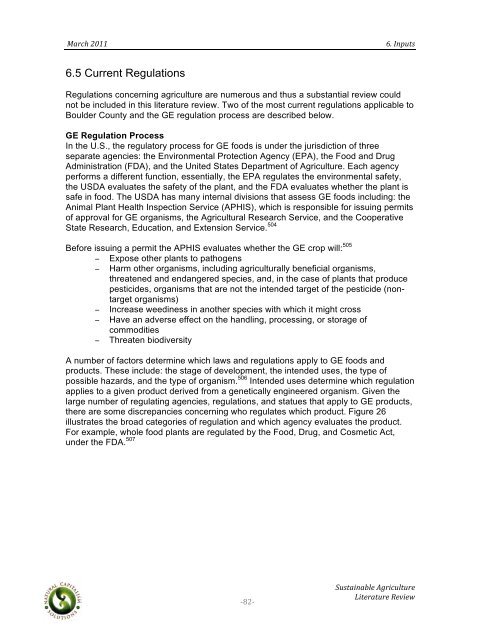Sustainable Agriculture Literature Review - Boulder County
Sustainable Agriculture Literature Review - Boulder County
Sustainable Agriculture Literature Review - Boulder County
Create successful ePaper yourself
Turn your PDF publications into a flip-book with our unique Google optimized e-Paper software.
! ! !!<br />
"#$%&!'())!! !!!!!!!!!!!!!!!!!!!!!!!!!!!!!!!!!!!!!!!!!!!!!!!!!!!!!!!!!!!!!!!!!!!!!!!!!!!!!!!!!=+!>5?324!<br />
6.5 Current Regulations<br />
Regulations concerning agriculture are numerous and thus a substantial review could<br />
not be included in this literature review. Two of the most current regulations applicable to<br />
<strong>Boulder</strong> <strong>County</strong> and the GE regulation process are described below.<br />
GE Regulation Process<br />
In the U.S., the regulatory process for GE foods is under the jurisdiction of three<br />
separate agencies: the Environmental Protection Agency (EPA), the Food and Drug<br />
Administration (FDA), and the United States Department of <strong>Agriculture</strong>. Each agency<br />
performs a different function, essentially, the EPA regulates the environmental safety,<br />
the USDA evaluates the safety of the plant, and the FDA evaluates whether the plant is<br />
safe in food. The USDA has many internal divisions that assess GE foods including: the<br />
Animal Plant Health Inspection Service (APHIS), which is responsible for issuing permits<br />
of approval for GE organisms, the Agricultural Research Service, and the Cooperative<br />
State Research, Education, and Extension Service. 504<br />
Before issuing a permit the APHIS evaluates whether the GE crop will: 505<br />
! Expose other plants to pathogens<br />
! Harm other organisms, including agriculturally beneficial organisms,<br />
threatened and endangered species, and, in the case of plants that produce<br />
pesticides, organisms that are not the intended target of the pesticide (nontarget<br />
organisms)<br />
! Increase weediness in another species with which it might cross<br />
! Have an adverse effect on the handling, processing, or storage of<br />
commodities<br />
! Threaten biodiversity<br />
A number of factors determine which laws and regulations apply to GE foods and<br />
products. These include: the stage of development, the intended uses, the type of<br />
possible hazards, and the type of organism. 506 Intended uses determine which regulation<br />
applies to a given product derived from a genetically engineered organism. Given the<br />
large number of regulating agencies, regulations, and statues that apply to GE products,<br />
there are some discrepancies concerning who regulates which product. Figure 26<br />
illustrates the broad categories of regulation and which agency evaluates the product.<br />
For example, whole food plants are regulated by the Food, Drug, and Cosmetic Act,<br />
under the FDA. 507<br />
!<br />
",("<br />
!,342#.5#6/1!78$.%3/23$1!<br />
9.21$#23$1!:1;.1
















